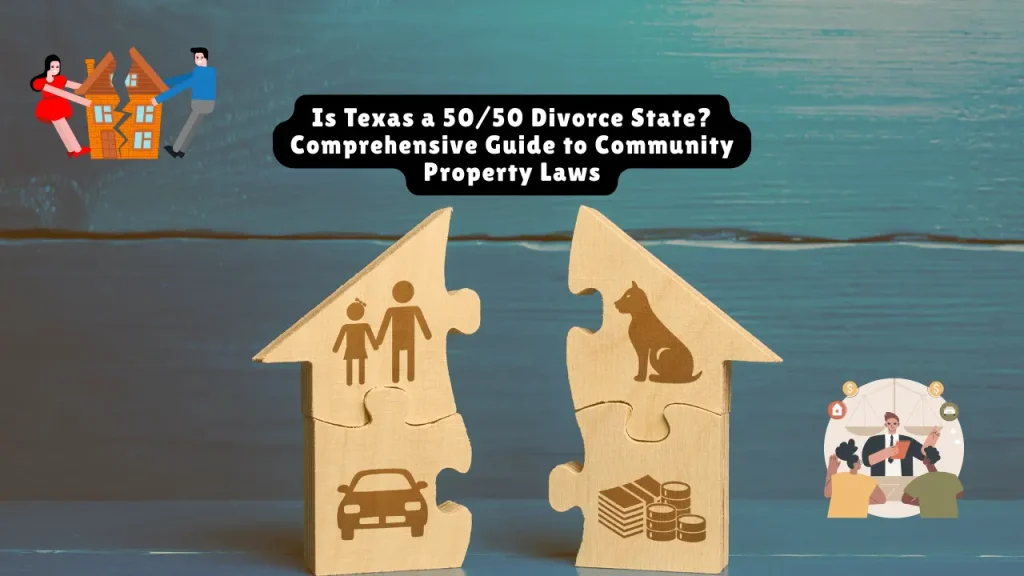Is Texas a 50/50 Divorce State? Comprehensive Guide to Community Property Laws
Yes, Texas is a community property state, which means that property acquired during a marriage is generally divided equally between spouses during a divorce. However, “50/50” does not always mean a straight-down-the-middle split. The law allows for “just and right” division, which can be unequal in certain situations.
Texas Is Not Automatically a 50/50 Divorce State
While many Texas divorces do result in an approximately equal division of assets, judges have the right to decide the split in a way that they deem fit, which could mean one spouse receives 60% and the other 40%, or any other division deemed appropriate.
Understanding this fundamental principle is crucial because it affects every aspect of your financial future after divorce. Let’s explore exactly how Texas community property laws work and what factors influence property division in your specific situation.
Table of Contents
Understanding Texas Community Property Laws: The Foundation
What Qualifies as Community Property in Texas?
In Texas, any property acquired by a couple during their marriage (with few exceptions) is equally owned by both spouses, regardless of whose name is on the title or account. This includes:
Community Property Examples:
- Income earned by either spouse during marriage
- Real estate purchased during marriage
- Vehicles bought with marital funds
- Investment accounts funded during marriage
- Business interests acquired during marriage
- Retirement benefits accrued during marriage
- Debts incurred during marriage
Separate Property Exceptions: Property acquired before marriage, by gift, or through inheritance is considered separate property and is not subject to division in a divorce. Additionally, personal injury recoveries (except for lost earning capacity) remain separate property.
The “Just and Right” Standard Explained
Texas Family Code Section 7.001 requires courts to order “a division of the estate of the parties in a manner that the court deems just and right, having due regard for the rights of each party and any children of the marriage.”
This legal standard gives Texas judges significant discretion in property division, unlike states with mandatory 50/50 splits. The court considers multiple factors to determine what constitutes a “just and right” division.
Related article: How Long Do You Have to Be Separated Before Divorce in VA?

Factors That Influence Property Division Beyond 50/50
1. Fault in the Breakdown of Marriage
Texas recognizes both no-fault and fault-based divorces. When fault is proven (such as adultery, cruelty, or abandonment), it can significantly impact property division. Courts may award a larger portion of community property to the innocent spouse.
Real-Life Example: Sarah discovered her husband Mark’s affair that lasted two years. Despite Mark earning significantly more during their 10-year marriage, the court awarded Sarah 65% of the community property, including the family home, due to Mark’s adultery.
2. Disparity in Earning Capacity
Courts consider factors like the duration of marriage and each spouse’s health when making property division decisions. If one spouse sacrificed career advancement for family responsibilities, they may receive a larger share.
Scenario Analysis: Jennifer left her corporate law career to raise three children during her 15-year marriage to David, a surgeon. Despite both initially earning similar incomes, Jennifer’s current earning capacity is significantly lower. The court awarded her 60% of community assets to account for this disparity.
3. Contributions to Marriage (Financial and Non-Financial)
Texas courts recognize both monetary and non-monetary contributions to marriage. Homemaking, child-rearing, and supporting a spouse’s career advancement are valued alongside financial contributions.
4. Size and Nature of Separate Property
If one spouse has substantial separate property, the court may award a larger portion of community property to the spouse with fewer separate assets to achieve overall fairness.
5. Children’s Best Interests
When minor children are involved, property division often favors maintaining stability for the children, which might mean awarding the family home to the custodial parent.
Related article: I Want A Divorce But My Wife Can’t Support Herself, Complete Legal and Financial Guide
Complex Asset Division Scenarios in Texas
High-Value Asset Situations
Business Ownership: When community property includes business interests, valuation becomes complex. Courts may award the business to one spouse while compensating the other with different assets of equal value.
Retirement Benefits: Community property retirement benefits are subject to division using the “just and right” standard, which usually means 50/50 but not always. Military pensions, 401(k)s, and other retirement accounts require careful evaluation of contributions made during marriage.
Real Estate Holdings: Multiple properties require individual assessment. The family home often goes to the spouse with primary child custody, while investment properties might be sold and proceeds divided.
Debt Division Complexities
Community debts are divided alongside community assets. However, a creditor’s right to collect debt is not affected by the divorce decree – both spouses may remain liable to creditors regardless of court orders.
Strategic Considerations:
- Credit card debt incurred for family expenses vs. individual purchases
- Student loans for degrees obtained during marriage
- Mortgage obligations on multiple properties
- Business debts tied to community property businesses
Protecting Your Interests: Prenuptial and Postnuptial Agreements
Prenuptial Agreement Impact
Valid prenuptial agreements can significantly alter property division outcomes. These agreements can:
- Designate certain assets as separate property
- Waive rights to spousal support
- Establish predetermined property division methods
- Protect family businesses or inheritances
Enforceability Requirements:
- Voluntary execution by both parties
- Full financial disclosure
- Reasonable terms not unconscionable at enforcement time
- Proper legal representation for both parties
Postnuptial Agreements
Texas recognizes postnuptial agreements that can modify property rights during marriage. These are particularly useful when:
- One spouse receives a large inheritance
- Starting a new business venture
- Significant changes in family circumstances occur
Step-by-Step Guide to Understanding Your Property Division
Phase 1: Property Characterization
- Inventory All Assets: Create comprehensive lists of all property, accounts, and debts
- Determine Timing: Establish when each asset was acquired
- Trace Separate Property: Document pre-marital assets and gifts/inheritances
- Identify Commingling Issues: Separate property mixed with community property requires careful analysis
Phase 2: Valuation Process
- Professional Appraisals: Obtain current market values for real estate, businesses, and valuable personal property
- Account Statements: Gather recent statements for all financial accounts
- Retirement Account Valuations: Determine community interest in all retirement benefits
- Debt Assessment: Calculate all community obligations
Phase 3: Division Strategy
- Negotiate Settlement: Most couples reach agreements outside court
- Mediation Options: Court-ordered or voluntary mediation can resolve disputes
- Trial Preparation: If settlement fails, prepare for judicial determination
Exceptions and Special Circumstances
Reimbursement Claims
When separate property funds improve community property (or vice versa), reimbursement claims may arise. For example, if you use inheritance money to renovate the marital home, you may be entitled to reimbursement.
Economic Contribution Factors
Courts may deviate from equal division when:
- One spouse wasted community assets on extramarital affairs
- Significant disparities in future earning potential exist
- Health issues affect one spouse’s financial prospects
- Educational sacrifices were made for the other spouse’s benefit
Temporary Orders Impact
During divorce proceedings, temporary orders for support and property use can influence final division. Strategic positioning during temporary hearings is crucial.
Common Misconceptions About Texas Property Division
Myth 1: “Automatic 50/50 Split”
The automatic 50/50 split is a myth. There is a common misconception that in all Texas divorce cases community property will be divided equally, but the legal standard is not 50/50.
Myth 2: “Fault Doesn’t Matter”
While Texas allows no-fault divorces, proven fault can significantly impact property division and spousal support awards.
Myth 3: “Separate Property Is Always Protected”
Separate property can become community property through commingling or by being used for community purposes without proper documentation.
Legal Resources and Next Steps
Essential Texas Family Code Sections
- Section 3.001: Definition of separate property
- Section 3.002: Definition of community property
- Section 7.001: General rule of property division
- Section 7.002: Special circumstances for property division
Professional Resources
Finding Qualified Attorneys:
- State Bar of Texas Lawyer Referral Service: texasbar.com
- Board Certified Family Law Specialists through Texas Board of Legal Specialization
- Local bar association referral services
Additional Support Resources:
- Texas Legal Aid: texaslawhelp.org
- Family law self-help resources at county courthouses
- Certified Divorce Financial Analysts for complex asset cases
Immediate Action Items
- Document Everything: Gather financial records, property deeds, and account statements
- Avoid Asset Waste: Don’t dispose of or hide community property
- Consult Professionals: Speak with experienced Texas family law attorneys
- Protect Credit: Monitor joint accounts and credit reports
- Consider Counseling: Explore mediation before litigation
Conclusion: Texas Property Division Successfully
Understanding that Texas is not automatically a 50/50 divorce state empowers you to make informed decisions about your financial future. While Texas is a community property state, courts divide community property as they deem “just and right,” which means your unique circumstances matter significantly.
The key to favorable property division outcomes lies in thorough preparation, understanding your rights under Texas law, and working with experienced professionals who can navigate the complexities of community property division. Whether your case involves simple asset division or complex business valuations, the “just and right” standard provides both challenges and opportunities for achieving fair results.
Remember that every divorce situation is unique, and what constitutes a “just and right” division varies based on your specific circumstances. Early consultation with qualified Texas family law attorneys can help you understand your rights, prepare your case effectively, and work toward the best possible outcome for your financial future.
This article provides general information about Texas divorce property division and should not be construed as legal advice. Laws may change, and individual circumstances vary significantly. Always consult with a qualified Texas family law attorney for advice specific to your situation.
Contact Information for Legal Assistance:
- Texas State Bar Lawyer Referral Service: 1-877-9TEXBAR
- Legal Aid Organizations: Visit texaslawhelp.org for income-qualified assistance
- County Family Court Self-Help Centers: Available in major Texas counties
About the Author

Sarah Klein, JD, is a former family law attorney with over a decade of courtroom and mediation experience. She has represented clients in divorce, custody cases, adoption, Alimony, and domestic violence cases across multiple U.S. jurisdictions.
At All About Lawyer, Sarah now uses her deep legal background to create easy-to-understand guides that help families navigate the legal system with clarity and confidence.
Every article is based on her real-world legal experience and reviewed to reflect current laws.
Read more about Sarah
